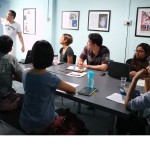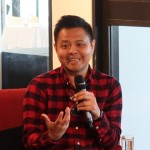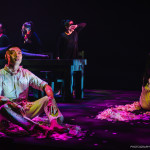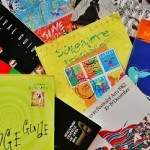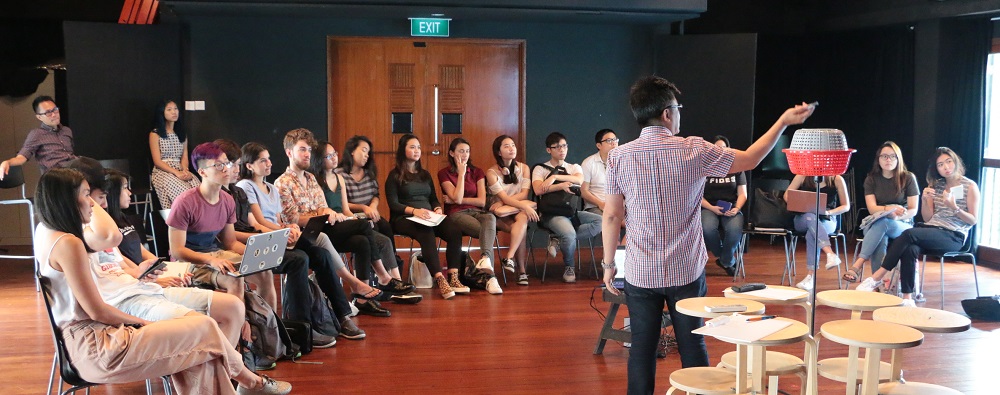
Students from the Singapore Management University’s Advanced Arts and Culture Management course visited Centre 42 in September to learn more about how we function as an arts centre. Photo: Daniel Teo.
How do you prepare students for the real world? That is the challenge faced by Hoe Su Fern, the assistant professor of Arts and Culture Management at the School of Social Sciences at the Singapore Management University (SMU).
Su Fern – who is armed with a PhD in cultural policy but has worked in a variety of sectors, from fashion to the government – is currently on a mission to groom the next generation of arts managers. She joined SMU in September 2016, and semester by semester, she’s been trying to instil in her students a sense of what it is like to work in arts management.
The field is vast and vaguely defined: arts managers can be responsible for everything from programming for an arts organisation, to facilitating with the day-to-day operations of the company, to managing budgets, marketing, and other administrative tasks for specific productions and projects.
While some things can be taught in school, some skills can really only be learnt on the job.
To ensure that her Arts Management students in the compulsory final year module “ACM004: Advanced Arts and Culture Management” can learn real-life skills, Su Fern designed a course that, as she puts it, “would allow them to learn both the critical thinking that is required of arts managers, and also the practical aspects of the role”. The students’ task is to work in teams to develop and present a proposal for a future arts centre in Singapore.
“I want this to be a project that’s meaningful and useful for them, and I’m hoping that they will really take ownership of it. And who knows? Maybe they really will develop it in the future,” says Su Fern. She adds that she deliberately left the definition of “arts centre” quite vague, as she hopes that her students can come up with their own ideas and meanings for it.
Su Fern has also strived to bring her teaching outside the classroom, by arranging for her students to visit existing arts centres in Singapore. She hopes that by speaking with staff from places like DECK, the Substation, and Centre 42, her students can learn about the various types of company structures out there, as well as sources of funding, and what the day-to-day operations of different companies are like.
After looking at case studies and doing their research, the final challenge for the students is to pitch their ideas – which comprise everything from the vision of their arts centres to how it will be implemented – to a live audience. This event, titled Partial Projections: Proposals for a Future Arts Centre in Singapore, will be held at Centre 42’s Black Box on 9 November, and it will be open to the public.
“For many of them, they’ve never done an assignment outside the classroom – I don’t think they know what’s in store for them yet!” she laughs.
The presentation will be accompanied by an outdoor exhibition, where students can provide more information about their arts centre and the thought process and research behind it.
Currently, the four groups all have their own unique ideas – and they’re all facing their own set of challenges.
“In the beginning, it was very hard to establish an idea that was not already out there,” says Bianca Westhuis, an exchange student on the course who joined SMU this semester. “But then we started thinking that while most of the ideas are in a way already out there, why are they not all successful? We hope to adjust some of these concepts in a way that will be successful.” Bianca’s group is hoping to create a platform where artists can network while giving them a space to create art.
Final year SMU student Lloyd Wong’s group, on the other hand, wants to create a centre for amateur theatre groups to test and rehearse new works. For them, the challenge is about finding a space. “Because our [proposed arts centre] is for theatre troupes, the location and size of the space is very crucial,” he says, adding that the group will be doing a series of site recces during their recess week in order to scope out existing spaces that they can gather ideas from.
The third group is proposing a centralised marketing platform for existing arts centres, while the fourth group would like to dedicate their arts centre to the alternative music scene.
Through the live presentation, Su Fern hopes that her students will also be able to take their first steps into the arts industry by connecting them with some of the players in it. “I want them to see that they can also be of relevance to the arts community,” she explains. “A lot of them do want to work in the arts, but they struggle and say they find that the arts ecology is too insular. So by holding the presentation at Centre 42, I’m trying to give them that stepping stone [into the real world].”
While Su Fern acknowledges that her students will not be able to examine everything in detail – the course is only 13 weeks long, after all – she hopes that it will at least give them a holistic overview of what being an arts manager is like.
“I want the course to really push them and prepare them for the possibility that they would become arts managers,” she says. “I think that we need more arts managers in Singapore, because they do add value to whatever project they are involved in – after all, it is the arts manager’s job to deliver the project.”
By Gwen Pew
Published on 12 October 2017
Join us for the students’ live pitching session, titled Partial Projections: Proposals for a Future Arts Centre in Singapore, at Centre 42 on 9 November 2017.

